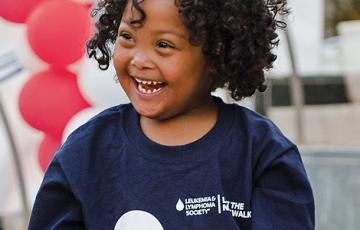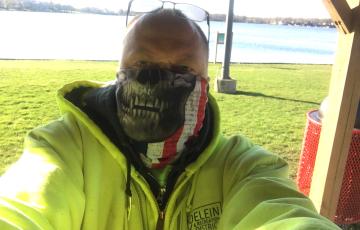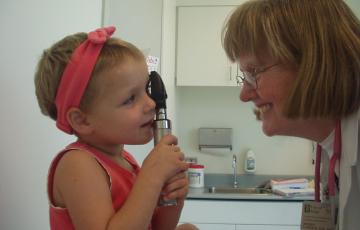Search Results

Kaidyn
Kaidyn was only six months old when he was diagnosed with acute myeloid leukemia (AML). About two months later, he received a bone marrow aspiration and was started on chemotherapy. Over the next ten months, Kaidyn was in and out of Children's Hospital of Oakland. It was there that he took his first steps, said his first words, and even flirted with every nurse in the oncology unit! Kaidyn is now a healthy three-year-old boy with an ear-to-ear grin who participates in his local Light The Night Walk each fall.

Reid
We just wanted to reach out and say how much The Leukemia & Lymphoma Society (LLS) has helped us. From attending Light The Night (LNT), to getting a blanket in the mail, to receiving funds when I couldn't work to keep Reid safe from the pandemic. Anytime I have needed assistance or reached out, the staff I have chatted with are so amazing and make you feel like you're so included and important. You have made us feel loved and gave us hope and inspiration. Reid was diagnosed at 2 years old, and he is almost done with B-cell acute lymphoblastic leukemia (B-cell ALL) treatment.
Jeff
A little over two years ago, I was diagnosed as having chronic lymphocytic leukemia (CLL). I was shocked and devastated by the news and immediately began seeing an oncologist. My team from the cancer center has been uplifting, positive, and supportive from the very beginning! They have been successfully treating my cancer and have taught me not to fear my disease.

Tony
I was diagnosed in 2016 with multiple myeloma (MM) and was able to get a bone marrow transplant in 2017. After I recovered, I was cancer-free for five years. Then two years ago, my cancer came back, and I am now going through with two types of therapies to keep things at bay and doing well. Besides the ups and downs of working full-time and cancer coming back, my oncologist who saw me through retired last December, and I got a new one. However I was not happy and started seeing one of his associates and really liked her, but she is now leaving the practice in two weeks.

Story
Story was diagnosed with biphenotypic leukemia (BAL) in July 2010. She was four years old at the time. She was treated with two rounds of “high-risk protocol” chemo. She was in complete remission after 60 days. However, because of her particular diagnosis, we were advised that she needed a bone marrow transplant to have the best chance of long-term remission. Her older sister, Lyric, who was just six at the time, was a perfect match.
Fertility
“Fertility” describes the ability to conceive a biological child. Human reproduction requires three elements: mature sperm, mature eggs and a person with a uterus to carry the pregnancy and give birth. Some cancers and some cancer treatments affect fertility.
Follow-Up Care
Find more information about follow-up care, including what to expect, long-term and late effects of treatment, survivorship clinics, and other resources, such as The National Comprehensive Cancer Network (NCCN) treatment guidelines.
Relapsed and Refractory
Some patients' cancer returns after a successful course of treatment. This is called a relapse.
Some patients' cancer does not respond to treatment. This is called refractory chronic myelomonocytic leukemia (CMML).
If you have relapsed or refractory CMML, talk with your doctor about whether taking part in a clinical trial may be a good option for you.
Martin
I have a unique story. In 1978 after being married for three weeks, my wife was diagnosed with acute lymphoblastic leukemia (ALL). Seven months later she passed away.

Katie
In October 2021, I was diagnosed with stage 2 Hodgkin lymphoma (HL). This journey of over 100 appointments has not been easy and something I never would have imagined I would walk through at the age of 26. I know God didn’t put me through this without a purpose. God has given me so much strength and confidence through this journey. I want to use it to encourage people in my life going through trials and hardships to see the light at the end of the tunnel and have confidence they will make it through it.

Marko
I am 18 years old and from a small town in New Jersey. I was diagnosed with stage 4 anaplastic large cell lymphoma (ALCL). I have spent my whole senior year of high school in the hospital not being able to be home for eight months and missing out on my whole senior year. Music has saved me while going through treatment, whether I would record my own music in my hospital bed or even listen to music to numb the pain I was in. If it wasn't for music, I’m not sure if I would be able to last going through treatments.

Sophia
When I was in middle school, my dad was diagnosed with acute lymphoblastic leukemia (ALL). During this time, The Leukemia and Lymphoma Society deeply supported our family. Sadly, my dad passed in 2021, but my loved ones and I continue to honor his spirit by making the most out of our lives. I became a volunteer because I strive for a future where cancer has a cure. All donations are deeply appreciated and will go to cancer research!

Tracey
I was diagnosed with chronic lymphocytic leukemia (CLL) in 2021 after a routine physical after my 50th birthday. It was a complete shock, and I was scared and unsure of what my future would look like. With the help of my doctors and The Leukemia & Lymphoma Society (LLS), I feel prepared to make informed decisions about my future. I participate in medical research studies and intend to join a clinical trial (that a clinical nurse at LLS told me about) when I need treatment.

Jaden
After having swollen lymph nodes for some time, my nine-year-old son, Jaden was diagnosed with lymphoma in May 2016. This little guy took the news like a champ.
He was admitted as an inpatient for eight days, and is now receiving outpatient chemotherapy. He is fighting cancer better than most adults and teaching everyone around us what it really means to be hopeful, faithful, brave, courageous and grateful.
Jordyn
In September 2013, our six-year-old daughter, Jordyn was diagnosed with T-cell lymphoblastic lymphoma— a diagnosis no parent ever wants to hear. Within a day of diagnosis, she already started chemotherapy. Numerous lumbar punctures and blood transfusions soon followed. Our life had changed in an instant.
Jordyn persevered through the hair loss, many overnight stays at the hospital, and frequent doctor visits for more than two years. Jordyn is our hero of strength. She has always kept a positive attitude during this battle— she calls it her fight with "Blob".

Kelly
In 2001, I was diagnosed with T-cell acute lymphoblastic leukemia (T-ALL) at age three and survived thanks to three and a half years of intense treatment at the City of Hope Los Angeles. I am now 25 years old, a college graduate, and working for The Leukemia & Lymphoma Society (LLS), hoping to give back to those who helped save my life. I have volunteered with LLS since 2009 after being chosen as their "Girl of the Year" to inspire candidates to raise money for blood cancer research. In 2017, I became a candidate for the Student of the Year campaign raising over $60,000 in seven weeks.

Lana
Lana's journey with The Leukemia & Lymphoma Society (LLS) began in 1991 when she was diagnosed with acute lymphoblastic leukemia (ALL). Overcoming numerous physical and cognitive challenges associated with her illness, Lana emerged as a dedicated advocate for cancer awareness and support. She became an integral part of the Orange County LLS community, participating in various programs such as Honored Hero, Light The Night, and So Cal Cancer Connection, among others.
Megan
At 31, I was diagnosed with acute myeloid leukemia (AML). It all started with what I thought was a cold or maybe COVID. I kept working, brushing off the symptoms as something minor. But things got worse. I had a persistent cough and unexplained bruises, and I felt constantly out of breath. When I lost part of the vision in my right eye, I knew something was seriously wrong, but without insurance, I hesitated to seek help.
Follow-Up Care
Click here for information about follow-up care, including what to expect, long-term and late effects of treatment, survivorship clinics, and other resources such as The National Comprehensive Cancer Network (NCCN) treatment guidelines.
Use the Survivorship Workbook to collect all the important information you need throughout diagnosis, treatment, follow-up care and long-term management of a blood cancer.
Follow-Up Care
Click here for information about follow-up care, including what to expect, long-term and late effects of treatment, survivorship clinics, and other resources such as The National Comprehensive Cancer Network (NCCN) treatment guidelines.
Use the Survivorship Workbook to collect all the important information you need throughout diagnosis, treatment, follow-up care and long-term management of a blood cancer.
Treatment Outcomes
In some people with PV, the disease remains stable for many years. In many people, life expectancy is the same as it would be if they did not have PV. With careful medical supervision and therapy, PV can usually be managed effectively for a long time. In some cases, however, it may progress to another type of blood disease, such as myelofibrosis or acute myeloid leukemia.
Treatment Outcomes
A few decades ago, there were very low cure rates in both children and adults diagnosed with ALL. Today, childhood ALL has one of the highest cure rates of all childhood cancers, approaching 92 percent for children younger than 15 years and more than 94 percent for children younger than 5 years.
Disease- and Treatment-Related Pain
People with cancer can have pain caused by the cancer itself, its treatment, or both. They may also have pain caused by other health problems that are unrelated to cancer (like arthritis or diabetes).
Increased pain does not mean that the cancer is getting worse, but you should always tell your healthcare team if you have increased pain.
It’s important to remember that no matter what the cause, pain can be treated.